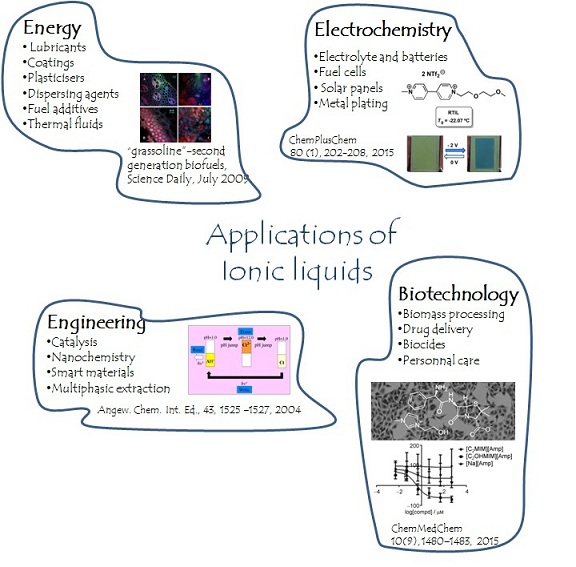
Development of functional ionic liquids
Ionic Liquids (ILs) as low temperature-melting salt (liquids at temperatures lower than 100 ºC) composed by the combination of large organic cations with variety of anions have been explored in last two decades as an attractive class of ionic organic compounds. They have some peculiar and tunable properties such as almost negligible vapour pressure, chemical and thermal stability, high ionic conductivity, ability to solubilize organic, inorganic and polymeric materials and a large electrochemical window. Nowadays, the interest from disciplines inside and outside chemistry and engineering is growing. ILs are indeed tunable, multipurpose materials for a variety of applications.

In this topic our research is focused on:
• Biological chiral molecules (e.g. aminoacids, sugars and nucleotides) for enantioselective catalytic processes (ACS Catalysis 2011; Synlett 2013),
•Active Pharmaceutical Ingredients (API-ILs) such as anti-inflammatory, antibiotic, neurodegenerative and cytostatic drugs that showed an effective improvement of polymorphism, stability and in bioavailability if compared with original solid APIs (MedChemComm 2013; RSC Advances 2014; PhysChemChemPhys 2015);
• innovative and Smart Materials such as intrinsically photochromic (Chem.Comm. 2009), electrochromic (Chem. Comm. 2011; RSC Advances 2013; CEJ 2014), magnetic, energetic and luminescent (Inorg. Chem. 2013, Dalton Trans. 2013, Polyhedron 2015) room temperature ILs for a variety of potential applications (J. Mat. Chem. A, 2013);
• Ionic Liquids as guest in Metal-organic Frameworks (IL@MOF) for gas separation and purification technologies
Development of chromogenic materials.
Development of new inorganic materials
Conservation and restauration of Portuguese cultural heritage